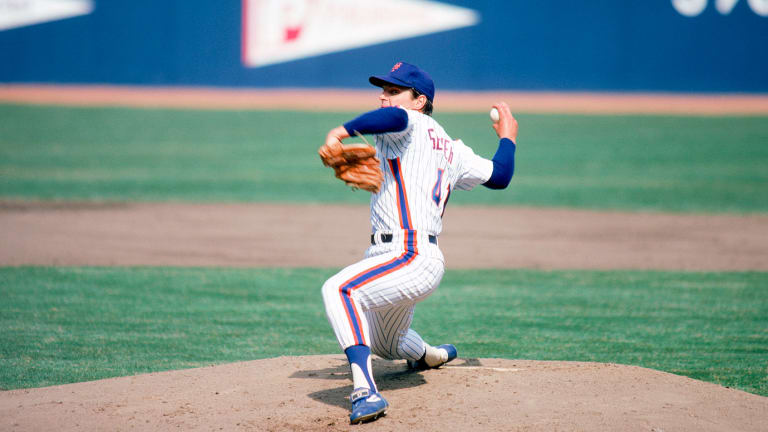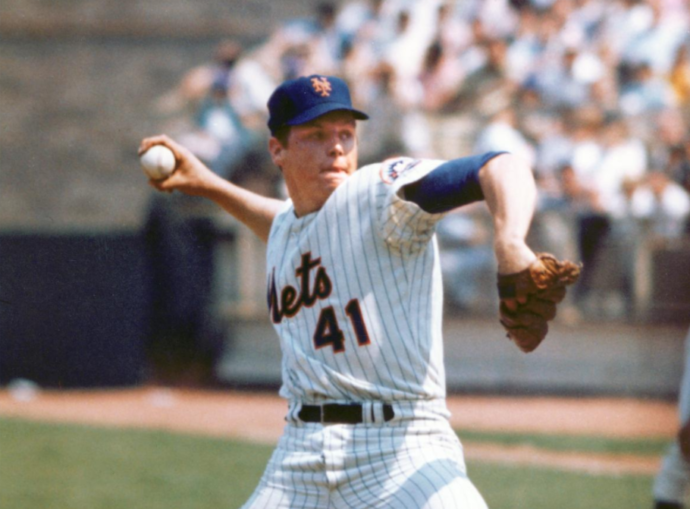
Tom Seaver.
We’re looking back at the 50th anniversary of the Mets’ 1973 National League pennant-winning team by reviewing the most inspirational figures of that remarkable run. Last but not least, “The Franchise,” who stood out again as the finest pitcher in baseball.
In the pantheon of great seasons from the greatest player in Mets’ history, this season isn’t at the top. And in the list of elite pitching performances, very few from 1973 stand about above any others.
It would be difficult, even for Tom Seaver, to match what he or the Mets did in 1969. Individually, equaling his numbers in 1971 (when he somehow wasn’t recognized as the league’s top pitcher) is asking a lot.
Seaver didn’t reach the same heights of ’69 four years later. Neither did his team. But he did win his second of three Cy Young awards. In many ways, the ’73 season turned out to be a very rewarding one for the ace of the New York staff. But it also brought its share of challenges.
By this, his seventh year in the big leagues, Seaver had become New York’s biggest sports figure. The public fully embraced his integrity, and intensity in a city that thrives on such qualities.
From 1970–72, Seaver fanned an average of 274 batters, led the National League in strikeouts twice, and claimed a pair of ERA titles. Still, somehow, he never added to his Cy Young collection. The most galling omission came in 1971, when Seaver constructed a career-low 1.76 ERA, a career-low 0.946 WHIP, a career-high 289 strikeouts, and a career-best 9.1 strikeouts per nine innings only to lose out to Chicago’s Fergie Jenkins and his 24 wins. Seaver had 20.
There would be no snub in ’73, a season in which he was one of few not missing time due to injury. Only twice did Seaver allow more than four runs in a start. And by mid-September, a replenished roster sparked a resurgence. Even as Seaver’s shoulder barked with soreness, the call of the pennant race didn’t go unanswered.
“For the last month, I didn’t have my stuff and I didn’t know where it was going, anyway,” Seaver said to the New York Times. “It’s tough trying to pitch like that.”
Seaver helped lock up the division and the Cy Young in Chicago with the help of Tug McGraw to earn his 19th win and secure an MLB-best 2.08 ERA. It didn’t come easily. A 5-0 New York lead became 5-2 in the sixth and a 6-2 advantage was narrowed to 6-4 in the seventh. After allowing his 11th hit, Seaver gave way to McGraw, who got the final nine outs.
He then attempted to win the NLCS opener in Cincinnati on his own. Seaver drove in the lone Mets’ run with his bat on a second-inning double that drove in Bud Harrelson. He kept the Reds in check and off the scoreboard until the eighth when Pete Rose took him deep to tie it up. Seaver stayed out into the bottom of the ninth, striking out a then-LCS record 13. But Johnny Bench‘s walk-off homer ruined an otherwise tremendous performance.
Seaver got another opportunity with the National League pennant at stake. He wasn’t nearly as sharp in this Game 5 at Shea Stadium. He struck out four and walked five (three intentionally) and allowed two runs. But he didn’t need to be as spectacular, because the Mets’ bats came alive. They scored twice in the first, four times in the fifth, and again in the sixth to give their ace a 7-2 lead. Seaver struggled to get through the ninth but again passed the baton to McGraw, who took them across the finish line.
Seaver appeared again as the World Series shifted to New York. He would have only two starts in this seven-game series, each coming with their own bit of frustration. He exited Game 3 tied after eight innings—a contest the Athletics eventually won in 11. As the Mets took the next two, Seaver was set for a potential close-out start in Oakland. With the luxury of a series lead, manager Yogi Berra could go with Seaver or his freshest arm, George Stone, and save Seaver for a potential winner-take-all. The ladder was a strong 12-3 during the season. Sore shoulder and all, Berra played his ace.
While Seaver was good over seven innings, allowing two runs, his opponent was better. Catfish Hunter allowed one run and pitched into the eighth. It remains one of the most scrutinized decisions in Mets’ history, but a matter that was no fault of Seaver’s.
Seaver’s last game as a Met was in 1983. It would have been easy to believe ten years earlier that all that time would’ve been spent in New York. But the rift between “The Franchise” and the franchise that began on an infamous night in June 1977 became a dark period in Queens. The Mets were irrelevant and it took until Seaver was let go a second time after ’83 that things began to look promising for the first time since their last pennant year.
















